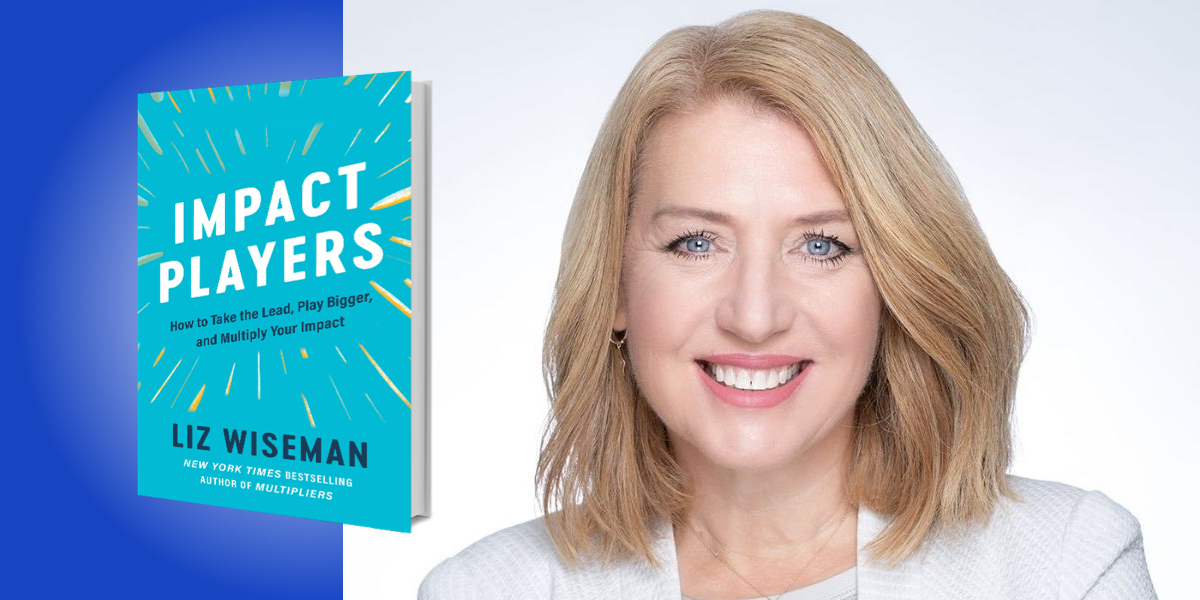Liz Wiseman is a bestselling author, researcher, and executive advisor who teaches leadership to executives around the world. She is the CEO of the Wiseman Group, a leadership research and development firm headquartered in Silicon Valley. Some of her recent clients include Apple, AT&T, Disney, Facebook, Google, Microsoft, Nike, Salesforce, Tesla, and Twitter. Liz has been named one of the top 10 leadership thinkers in the world, and she is a frequent guest lecturer at BYU and Stanford University.
Below, Liz shares 5 key insights from her new book, Impact Players: How to Take the Lead, Play Bigger, and Multiply Your Impact. Listen to the audio version—read by Liz herself—in the Next Big Idea App.
1. The difference between Impact Players and other contributors lies in how Impact Players handle everyday challenges.
While we might think that the Impact Players are the heroes that emerge in times of major crisis, they actually stand out in how they handle daily challenges such as: a problem that everyone can see but no one owns; a meeting with countless participants but no clear leaders; a new endeavor with never-before-seen obstacles; or a project with constantly changing goals or a continually increasing workload.
Typical professionals approach these everyday challenges as nuisances that jeopardize their productivity, so they tend to avoid them, the way a novice ocean swimmer turns and runs from a massive oncoming wave, and then gets tossed in the surf. The Impact Players in our study, however, tend to dive into these challenges the way an experienced surfer dives into and through an oncoming wave to get out to the bigger waves. They dive in, not because they love uncertainty or ambiguity, but because they see these everyday challenges as opportunities.
To them, unclear direction and changing priorities look like a chance to add value or to innovate, much like Jethro Jones. When he was interviewing for the job of principal at a middle school in Alaska, he was surprised to learn that the school was on track to be closed within a couple years, unless there was a massive transformation and a major boost in enrollment. He took the job anyway. He told the staff that their situation presented an opportunity to rethink their practices, to experiment without a looming fear of failure, and to completely rethink their education programs—with students actually taking the lead, along with teachers to supervise. They did this, and not only did the school remain open, but the model they built was adopted across the entire district.
Impact Players are energized by messy problems that would enervate or deter others. Lack of clarity doesn’t paralyze them; it tends to provoke them. Invitations to make changes are intriguing, not intimidating. In short, Impact Players see these everyday challenges through an opportunity lens, while others are looking at the same challenges through a threat lens.
2. Influence and impact have more to do with your mental game than sheer mental ability or effort.
The Impact Players weren’t necessarily more gifted than their peers, but because they thought about problems differently, they were able to respond in more valuable and impactful ways. Specifically, they thought about and responded differently to these five everyday challenges:
- The first is messy problems. Typical contributors tend to see complex problems (the type that don’t fall into any one person’s job) as a distraction. So they just focus on their job, and they tend to do it well. But Impact Players see these as a chance to be useful, so they venture beyond their job boundaries and do the job that needs to be done. This is how Scott O’Neil, CEO of some of the biggest sports franchises, began his career. When he discovered that the office copier was broken, he figured he’d fix it. His arms were stained with printer toner up to his elbows when Jon Spoelstra, the president of the New Jersey Nets, recognized him as one of the new recruits in marketing. He was so impressed that he invited Scott into his office and gave him a bigger job with bigger, messy problems. And then another and then another.
- The second of these everyday challenges is unclear roles. In collaborative settings where everyone works together but no one knows who’s in charge, typical contributors see this lack of clarity as a reason to look for leadership. They ask for role clarification. But Impact players see this leadership vacuum as an opportunity to provide leadership, and they step up and lead. Like Ellie Vondenkamp, a technology project manager at Target, who noticed some duplication of efforts and unnecessary spending when building out new stores. No one was really in charge of that area, but she stepped up and took the lead. She called a cross-functional team together, she shined a spotlight on the problem, and then she invited collaboration and for everyone to look for solutions. But she didn’t hold on to the lead—as soon as owners for these solutions emerged, she stepped back and let others lead the implementation. Impact Players like Ellie practice a fluid form of leadership, stepping up and also stepping back.
- The third situation is unforeseen obstacles. Typical contributors take ownership and responsible action, but when unexpected obstacles arise, they usually see them as an added hassle, something beyond their control—so they escalate the problem up the management chain. However, Impact Players tend to see these same obstacles as a chance to do things a better way, so they stick with things and get the entire job done, even when it becomes hard.
- The fourth type of challenge is moving targets. When circumstances change and goals shift mid-project, most professionals see it as annoying or unfair, or as a threat to their stability or comfort. As a result, they tend to stick to what they know best. In the same volatile conditions, Impact Players see a reason to evolve and to build new capabilities, so they adapt. While others attempt to manage and minimize change, Impact Players are learning and adapting to change.
- The last of these everyday challenges is unrelenting demands. When a team is weighed down, typical contributors focus on carrying their weight—but as pressure mounts, they see that as a reason to ask for help, and they look to their leaders to relieve the burden. In the same situation, Impact Players make work easier for all. They provide lift, not by taking on other people’s work, but by being easier to work with themselves, and bringing a levity that creates a sense of buoyancy. While others add to the load, Impact Players make heavy demands feel lighter for all.
3. The distinction between the Impact Player and the contributor is not a classification of individuals, but of practices.
It’s a contrast of two different modes of thinking: the Impact Player Mindset and the Contributor Mindset. These are mindsets that we all tend to move in and out of, and sometimes we need a nudge to get back to the mindset we held in our more productive, influential, and impactful times. If you want to increase your impact and do work that really matters, you can start by asking yourself, “Which mindset am I using right now? Am I looking at these unavoidable challenges as threats to my productivity, performance, success, or relative comfort? Am I seeing this through a threat lens, or through an opportunity lens?”
4. We can end up under-contributing by over-contributing.
So many professionals who miss the mark are well-intentioned but misguided. Here are four of the ways that I’ve seen people thwart their own efforts and reduce their own impact, all while trying to do the right things:
- Overworking. A lot of people work hard, but they don’t point their efforts in the right direction. They have the force, but not the right vector.
- The second is that they are over-eager. While making an impact requires intentionality, some people are overly intentional, and end up under-contributing. They may try too hard or play too big. They may push their agenda so hard or seek so much personal feedback that it becomes a burden on their colleagues. And rather than allowing their reputation to develop as a natural byproduct of the value they create, some people over-manage their image and their brand.
- The next is playing by the rules. Some people get tripped up because they play by an outdated rule book. Workplace etiquette may have taught them to be diligent, vigilant, and unflappable, but as the environment changes, simply staying in our own lane can sideline us. As the rules change, we must change as well.
- Lastly, playing it safe. Some people are missing opportunities to contribute to the most important work because they’re shying away from the ambiguity and uncertainty that often come with high-stakes situations, new initiatives, or changes in direction. Others gett stuck playing to their strengths, rather than venturing into new terrain and building greater influence on the issues that matter most.
5. There are missing Impact Players.
In trying to understand why some professionals become extraordinarily impactful, one cannot ignore the effects of bias. Because the potential for bias is hard-wired into human cognition, “sameness” tends to have a high default value. This can shape whose contribution is perceived as valuable and influential, but it also means that individuals who don’t fit the dominant profile may be underrepresented—or even when well-represented, they may be underutilized and underappreciated. So even in well-managed organizations, there are hidden pools of aspiring leaders and Impact Players who are not seen or getting their turn, or who are not receiving the same levels of investment.
If managers want to build a team of Impact Players, they need to start by letting go of a couple of assumptions: The first is that a team has a single MVP or a few superstars, an idea that usually leads to certain people being over-worked and others underutilized—both of which lead to burnout. The second fallacy is that Impact Players are just those in visible roles with tangible, measurable economic value.
To build a team where everyone is contributing at their fullest, managers need to develop a culture where people feel both comfortable and challenged; it’s a combination of safety and stretch that leads to impact. And managers need to create an environment that’s inclusive of diverse talent and celebrates those who could easily be “the missing Impact Player.”
To listen to the audio version read by author Liz Wiseman, download the Next Big Idea App today:































